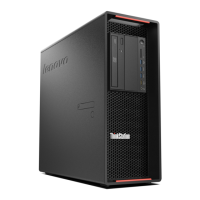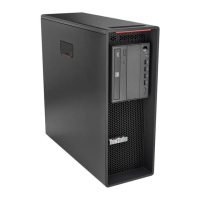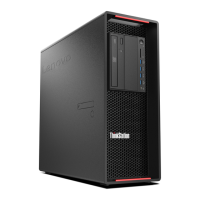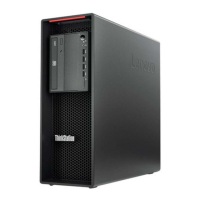Do you have a question about the Lenovo ThinkStation P710 and is the answer not in the manual?
Precautions to avoid damage from static electricity when handling computer components.
Guidelines for safe usage, connection, and routing of power cords and adapters.
Essential precautions for maintaining proper airflow and preventing overheating.
Instructions for safely cleaning the computer and workspace surfaces.
Identifies and illustrates the location of various computer hardware components.
Details connectors, controls, and indicators on the front of the computer.
Illustrates and describes connectors on the rear panel of the computer.
Overview of internal parts and their locations within the computer.
Information on supported storage devices and their installation in drive bays.
Explains the importance of the machine type and model label for identification.
Describes various features and capabilities of the computer system.
Information on accessing and using preinstalled Lenovo and Windows programs.
Instructions on how to register the computer with Lenovo for service and support.
Steps to adjust the computer's audio volume settings.
Guidelines and procedures for using optical drives and discs.
Instructions for connecting the computer to Ethernet and wireless networks.
Steps to establish a wireless connection with Bluetooth devices.
Advice on setting up an ergonomic and productive workspace.
Information on features and tools to assist users with disabilities.
Detailed instructions for safely cleaning the computer's exterior and screen.
Guidelines for basic and good maintenance practices to ensure reliable operation.
How to obtain and install the latest system updates for optimal performance.
Methods for securing the computer using physical locks and software features.
Instructions for using a cable lock to deter theft.
How to access and modify security configurations within the BIOS Setup Utility.
Methods for enhancing security through BIOS and Windows account passwords.
Steps to enable and use fingerprint reader for secure user access.
How to enable and use the switch that detects computer cover status.
Guide to navigating and changing system configuration settings in the BIOS Setup Utility.
Procedures for enabling or disabling hardware devices via the Setup Utility.
Setting and managing power-on, administrator, and hard disk passwords.
Changing the sequence of devices from which the computer boots.
Procedures for updating or recovering the system's BIOS firmware.
Instructions for setting up Redundant Array of Independent Disks (RAID) configurations.
A systematic approach to diagnosing and resolving common computer issues.
Solutions for specific hardware and software problems with detailed steps.
Guidance on resolving issues when the computer fails to start.
Steps to troubleshoot and fix issues related to sound output.
How to resolve issues with storage drives not being recognized or accessible.
Troubleshooting steps for connectivity issues with wired Ethernet networks.
Tips for optimizing computer performance and resolving slowness.
Information on using diagnostic tools to test hardware components.
Procedures for recovering the operating system and restoring data.
Essential precautions to prevent damage to sensitive components from static electricity.
Steps to safely prepare the computer and access internal components.
How to connect and install external peripherals like speakers or printers.
Procedures for installing or replacing devices in the optical drive bay.
Detailed instructions for installing or replacing various types of internal storage drives.
Procedures for replacing the heat sink and fan assembly, including safety precautions.
Instructions for installing or replacing RAM modules.
Information and procedures for replacing the computer's battery.
Final steps to reassemble the computer after hardware installation or replacement.
Links and references to find useful information about the computer.
Using the built-in Windows help and support features.
Information on important safety guidelines and product warranty terms.
Resources available on the Lenovo website for support, purchasing, and information.
Accessing drivers, software, diagnostics, and product details.
How to obtain technical assistance and service during and after the warranty period.
Lists supported UDIMM types and their corresponding memory speeds.
Lists supported RDIMM types and their corresponding memory speeds.
Information on the product's export classification and re-export restrictions.
FCC compliance statement for electronic emissions.
EU compliance statements for EMC and Radio Equipment Directives.
Information on accessing further regulatory notices via the Lenovo website.
Explains WEEE marking and regulations for recycling electronics.
Guidelines for recycling Lenovo computers and monitors in Japan.
Information on battery recycling regulations within the EU.
Compliance statement regarding hazardous substances in electrical and electronic equipment.
Information related to China's RoHS regulations.
Information regarding RoHS compliance for Taiwan.
Information about the ENERGY STAR program and Lenovo's compliant products.
Recommended power management settings for energy efficiency.
Lists trademarks of Lenovo and other companies.
Precautions to avoid damage from static electricity when handling computer components.
Guidelines for safe usage, connection, and routing of power cords and adapters.
Essential precautions for maintaining proper airflow and preventing overheating.
Instructions for safely cleaning the computer and workspace surfaces.
Identifies and illustrates the location of various computer hardware components.
Details connectors, controls, and indicators on the front of the computer.
Illustrates and describes connectors on the rear panel of the computer.
Overview of internal parts and their locations within the computer.
Information on supported storage devices and their installation in drive bays.
Explains the importance of the machine type and model label for identification.
Describes various features and capabilities of the computer system.
Information on accessing and using preinstalled Lenovo and Windows programs.
Instructions on how to register the computer with Lenovo for service and support.
Steps to adjust the computer's audio volume settings.
Guidelines and procedures for using optical drives and discs.
Instructions for connecting the computer to Ethernet and wireless networks.
Steps to establish a wireless connection with Bluetooth devices.
Advice on setting up an ergonomic and productive workspace.
Information on features and tools to assist users with disabilities.
Detailed instructions for safely cleaning the computer's exterior and screen.
Guidelines for basic and good maintenance practices to ensure reliable operation.
How to obtain and install the latest system updates for optimal performance.
Methods for securing the computer using physical locks and software features.
Instructions for using a cable lock to deter theft.
How to access and modify security configurations within the BIOS Setup Utility.
Methods for enhancing security through BIOS and Windows account passwords.
Steps to enable and use fingerprint reader for secure user access.
How to enable and use the switch that detects computer cover status.
Guide to navigating and changing system configuration settings in the BIOS Setup Utility.
Procedures for enabling or disabling hardware devices via the Setup Utility.
Setting and managing power-on, administrator, and hard disk passwords.
Changing the sequence of devices from which the computer boots.
Procedures for updating or recovering the system's BIOS firmware.
Instructions for setting up Redundant Array of Independent Disks (RAID) configurations.
A systematic approach to diagnosing and resolving common computer issues.
Solutions for specific hardware and software problems with detailed steps.
Guidance on resolving issues when the computer fails to start.
Steps to troubleshoot and fix issues related to sound output.
How to resolve issues with storage drives not being recognized or accessible.
Troubleshooting steps for connectivity issues with wired Ethernet networks.
Tips for optimizing computer performance and resolving slowness.
Information on using diagnostic tools to test hardware components.
Procedures for recovering the operating system and restoring data.
Essential precautions to prevent damage to sensitive components from static electricity.
Steps to safely prepare the computer and access internal components.
How to connect and install external peripherals like speakers or printers.
Procedures for installing or replacing devices in the optical drive bay.
Detailed instructions for installing or replacing various types of internal storage drives.
Procedures for replacing the heat sink and fan assembly, including safety precautions.
Instructions for installing or replacing RAM modules.
Information and procedures for replacing the computer's battery.
Final steps to reassemble the computer after hardware installation or replacement.
Links and references to find useful information about the computer.
Using the built-in Windows help and support features.
Information on important safety guidelines and product warranty terms.
Resources available on the Lenovo website for support, purchasing, and information.
Accessing drivers, software, diagnostics, and product details.
How to obtain technical assistance and service during and after the warranty period.
Lists supported UDIMM types and their corresponding memory speeds.
Lists supported RDIMM types and their corresponding memory speeds.
Information on the product's export classification and re-export restrictions.
FCC compliance statement for electronic emissions.
EU compliance statements for EMC and Radio Equipment Directives.
Information on accessing further regulatory notices via the Lenovo website.
Explains WEEE marking and regulations for recycling electronics.
Guidelines for recycling Lenovo computers and monitors in Japan.
Information on battery recycling regulations within the EU.
Compliance statement regarding hazardous substances in electrical and electronic equipment.
Information related to China's RoHS regulations.
Information regarding RoHS compliance for Taiwan.
Information about the ENERGY STAR program and Lenovo's compliant products.
Recommended power management settings for energy efficiency.
Lists trademarks of Lenovo and other companies.
| Tcase | 73 °C |
|---|---|
| Bus type | QPI |
| Stepping | R0 |
| Tjunction | - °C |
| FSB Parity | - |
| Processor cache | 10 MB |
| Processor cores | 4 |
| Processor model | E5-2623V4 |
| System bus rate | 8 GT/s |
| Processor series | Intel Xeon E5-2600 v4 |
| Processor socket | LGA 2011-v3 |
| Processor threads | 8 |
| Processor codename | Broadwell |
| Number of QPI links | 2 |
| Processor frequency | 2.6 GHz |
| Processor cache type | Smart Cache |
| Configurable TDP-down | - W |
| Processor lithography | 14 nm |
| Processor manufacturer | Intel |
| PCI Express slots version | 3.0 |
| Processor boost frequency | 3.2 GHz |
| Processor operating modes | 64-bit |
| ECC supported by processor | Yes |
| Thermal Design Power (TDP) | 85 W |
| Number of processors installed | 1 |
| Maximum number of PCI Express lanes | 40 |
| Memory types supported by processor | DDR4-SDRAM |
| Memory voltage supported by processor | - V |
| Memory clock speeds supported by processor | 1600, 1866, 2133 MHz |
| Memory bandwidth supported by processor (max) | 68.3 GB/s |
| Maximum internal memory supported by processor | 1536 GB |
| Scalability | 2S |
| Processor code | SR2PJ |
| Processor ARK ID | 92980 |
| Intel HD Graphics | No |
| Processor package size | 45 x 52.5 mm |
| Graphics & IMC lithography | - nm |
| Supported instruction sets | AVX 2.0 |
| Intel Secure Key Technology version | 1.00 |
| Intel Identity Protection Technology version | 0.00 |
| Internal memory | 16 GB |
| Memory channels | Quad-channel |
| Memory clock speed | 2400 MHz |
| Maximum internal memory | 384 GB |
| Discrete graphics card model | NVIDIA® Quadro® M2000 |
| On-board graphics card model | Not available |
| Discrete graphics card memory | 4 GB |
| Chassis type | Tower |
| Product color | Black |
| Placement supported | Vertical |
| Audio chip | Realtek ALC662 |
| Product type | Workstation |
| Motherboard chipset | Intel® C612 |
| RAID levels | 0, 1, 5, 10 |
| SSD capacity | The Solid State Drive's storage capacity in Gigabytes. |
| SSD interface | SATA III |
| Storage media | SSD |
| Optical drive type | DVD±RW |
| Total storage capacity | 256 GB |
| Operating system installed | Windows 7 Professional |
| Optional operating system supplied | Windows 10 Pro |
| Cabling technology | 10/100/1000Base-T(X) |
| Ethernet LAN data rates | 10, 100, 1000 Mbit/s |
| USB 2.0 ports quantity | USB 2.0 ports have a data transmission speed of 480 Mbps, and are backwards compatible with USB 1.1 ports. You can connect all kinds of peripheral devices to them. |
| USB 3.2 Gen 1 (3.1 Gen 1) Type-C ports quantity | 0 |
| Operating altitude | 0 - 3048 m |
| Storage temperature (T-T) | -10 - 60 °C |
| Operating temperature (T-T) | 10 - 35 °C |
| Storage relative humidity (H-H) | 10 - 90 % |
| Operating relative humidity (H-H) | 10 - 80 % |
| Sustainability certificates | RoHS, EPEAT Gold, ENERGY STAR |
| PCI Express x16 (Gen 3.x) slots | 3 |
| Power supply | 850 W |
| Depth | 485 mm |
|---|---|
| Width | 175 mm |
| Height | 446 mm |
| Weight | 23700 g |











